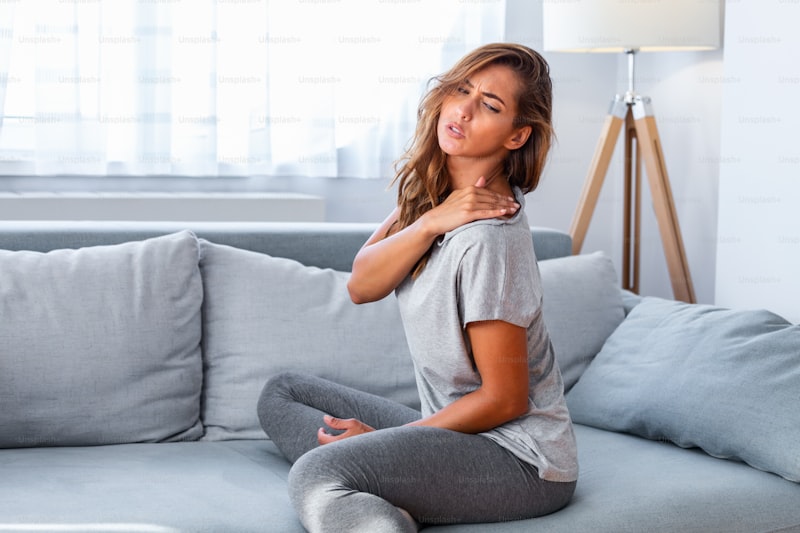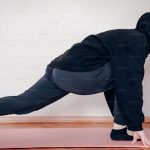As a novice yogi, I clearly remember the frustration of poor upper body strength. My shoulders were so weak that chaturaṅga daṇḍāsana resembled a breakdancing caterpillar and iconic poses like bakāsana (crow) and handstands were an impossible dream. But I was not alone. Many people lack strength in their shoulders when they first come to yoga. Modern lifestyle no longer routinely includes the heavy lifting and hard labour that kept our ancestors naturally strong in the arm.
This does not mean that we can’t all aspire to super strong shoulders. Muscles have the capacity to become stronger throughout life. Even in older age, muscles will build with increased loading. So, how can we do this safely and effectively?
The Arm Bone is Connected to the …
The shoulders are so much more than just the ball and socket joint between the humerus (upper arm bone) and scapula (shoulder blade). Yes, this is where the movement seems to happen but much of the function of the shoulder comes from the scapula moving too. If the scapula is not able to move, due to something like frozen shoulder, the arm will not lift very high – possibly not even to shoulder height – and is likely to be painful.
Equally, if the rotator cuff (muscles around the scapula and shoulder) are weak or working inefficiently, the arm will move but not be very strong. It may also be painful with this too.
The muscles of the upper back are also really important to shoulder function. The rhomboids and serratus anterior work in a kind of tug-of-war to balance the scapula on the chest. This gives the shoulder a good, solid foundation to work from.
Posture, Posture, Posture
Another reason for poor shoulder function is tightness in the structures on the front of the chest. Often the pectoral muscles are tight in people who sit and slouch a lot. Ironically they are also tight in gym goers who work on the front of the chest but not the upper back.
When the front of the shoulders are tight, the muscles around the upper back and scapula are often long and weak – too weak to pull the shoulders back into a good posture. This is called Upper Crossed Syndrome, it is seen in round shouldered individuals – and is really common. But the good news is, these problems are easily solved and yoga is one of the very best ways to solve them! Even www.NHS.uk recommends yoga as an ideal strength training for older adults. And what works for our older bodies will be even better for younger ones!
Yoga is the Journey
So, where to start? It is easy to get carried away and do too much too soon. Some yoga students are tempted to just plug away at arm balances and chaturaṅga daṇḍāsana over, and over, and over again … And they usually end up with sore shoulders and REALLY bad movement patterns.
But there is a safer way. With patience and practise, you can enjoy a wonderful journey towards strong shoulders and better posture. Here are my 3 stepping stones on that pathway to super strong shoulders.
- Open the chest – working to mobilise the myofascial structures across the front of the chest and shoulders allows the shoulders to settle back into a more efficient position. This work allows posture to improve and lays the foundations for strengthening.
- Strengthen only where movement patterns are perfect – this means modifying a pose until you can do it perfectly. Things like taking plank on to knees in sun salutes and working through chaturaṅga here until you can do it with a straight body AND elbows skimming the side of the chest. Then, (and only then) try the full version from high plank. This may take a while but be patient. It is worth it!
- Listen to your body – as soon as you notice your technique faltering – STOP! Do not practice poor movement patterns. If you can only do one perfect plank – just do one. THEN return to the modified version to continue to build strength. Some days I know I can nail arm balances, other days – no chance. So I do something else. Or return to the modification – this is not failure, this is wisdom.
Practice Makes Perfect
All you need to remember is
‘practice and all is coming’. (Patthabi Jois)
But, remember, nothing in yoga should be painful. DO NOT push through pain. Aim for a sensation of mild stretch that stays the same or eases as you hold the pose. And do not hold through juddering muscles – this is telling you the muscles are fatigued and need a short rest.
So, with that in mind, here are a few of my favourite poses for super strong, open shoulders.
- Chest opening – supine knee rolling and resting on your back over foam roller or bolster along the spine will start to open the front of the shoulders (remember to have the head supported too). Taking the arms out to shoulder height increases the stretch in the pectoral muscles and front of shoulder. Prasaritta padottanāsana version C (wide legged forward fold with arms clasped behind back) is a great chest opener if you aim the clasped hands upwards, even overhead if you can.
- Plank preparation – start on hands and knees. Tuck the toes under, push through the hands and lift knees a fraction of a centimetre – hold for a few slow breaths then release. Try arching into ‘angry cat’ as you hold to activate serrates anterior.
- Down dog – wonderful place to work on strengthening and opening shoulders at the same time. Aim chest for thighs and tailbone for the ceiling. Imagine you are squeezing a beach ball between your slightly bent elbows, while you draw the shoulder blades gently towards the waist. To progress this – lift one leg into 3 legged dog as you hold the upper body actions.
- Dolphin – another 2 for the price of one pose. Opens shoulders and strengthens in preparation for arm balances. Can also be progressed with alternate leg lifts into a sort of 3 legged dolphin (if there is such a thing ….)
- Work those arms in standing poses – virabhadrāsana 2 (warrior 2) and trikonasana (triangle) are a great opportunity to work the rhomboids by drawing shoulder blades together and gently towards waist. And, at the same time, activate serratus anterior to push hands away from each other. This dual action helps to develop the strong foundation around the shoulder blade that strong shoulders need.
- Modified wild thing – this develops single arm balance strength in preparation for side planks and the full version of wild thing. I usually enter it from janusirsasana (head to knee pose). Prepare by placing the hand on side of bent knee behind that buttock. Then push through hand and shin of bent knee to lift the pelvis skywards stretching the free hand overhead towards the wall behind you. Hold for a few breaths as you stretch through the whole of the front of the body. Bending the weight bearing elbow a little encourages muscle contraction and builds even more strength.
Every yogi has the potential to improve their posture and practise. Shoulders will open with patient, mindful practice. Strength will build with perseverance. Slow and steady is the way forwards. I hope you enjoy your path to super strong shoulders as much as I am. I may never be able to impress with handstands but I really don’t care! The journey is SO much more than the destination. Care to join me?













